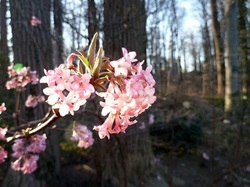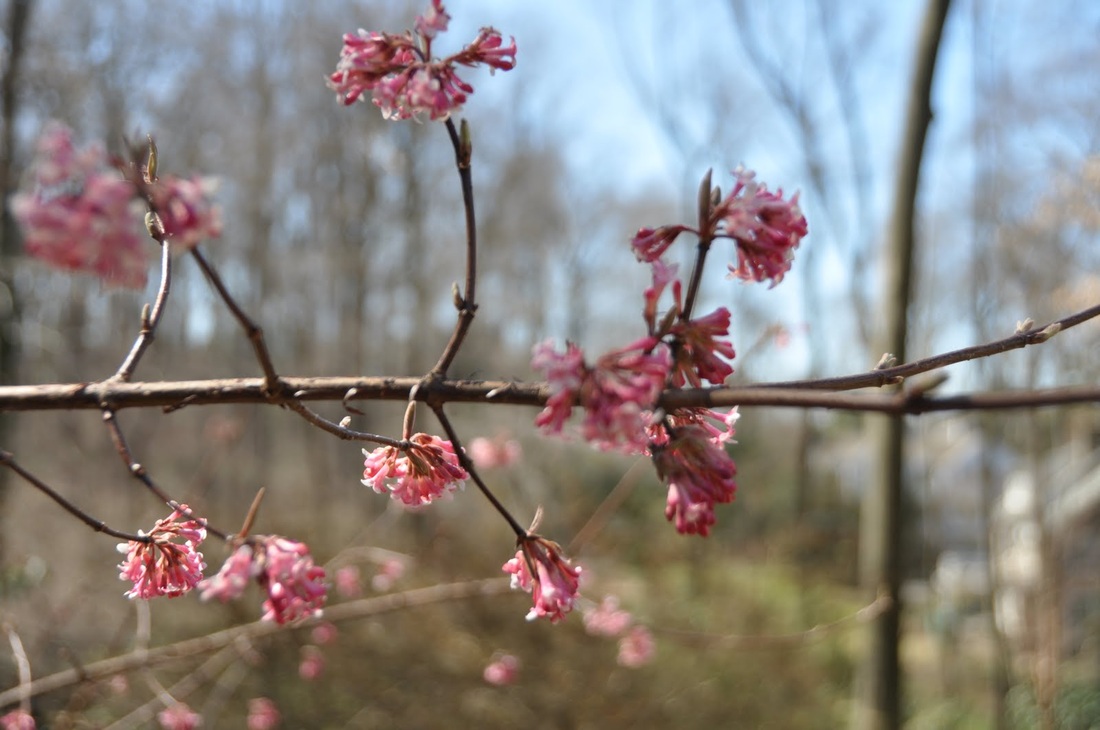
The Ribes sanguineum (Winter or Flowering currant) I planted years ago as a tiny stick from Forest Farm has begun to flower.
The Facts
Family: Grossulariaceae
Genus: Ribes Species: sanguineum Common Name: Winter currant, Flowering currant
Area of Origin: Pacific northwest
Characteristics: It's a large deciduous spring flowering upright woody shrub (usually 6' - 12' tall with a similar spread) which can be leggy with age. The dark green leaves are lobed and very textured. Fall color is not noteworthy, sometimes the leaves have reddish overtones, usually they just turn brown and drop off. The flowers are meant to have a spicy fragrance (very light in mine) and are are beautifully intricate, hanging in delicate clusters of red, pink or white. Some plants can form clusters of fruit with a heavy wax coating that leaves them looking bluish-gray.
Hardiness: USDA Zones 5 to 8.
Cultivation needs: Easy to grow, prefers part shade, ours is at the edge of the woods and in summer months is in fairly deep shade. It should be pruned after flowering to shape it and remove unwanted branches. I planted several a few years ago, my favorite is Ribes sanguineum "King Edward VII", a cultivar with red flowers that stays slightly shorter than most winter currants.
Typical Pests, Diseases, associated problems: Can get scale insects.
Propagation Method: From hardwood cuttings, seeds direct sown outdoors in fall or indoors before last frost or simple layering
The Facts
Family: Grossulariaceae
Genus: Ribes Species: sanguineum Common Name: Winter currant, Flowering currant
Area of Origin: Pacific northwest
Characteristics: It's a large deciduous spring flowering upright woody shrub (usually 6' - 12' tall with a similar spread) which can be leggy with age. The dark green leaves are lobed and very textured. Fall color is not noteworthy, sometimes the leaves have reddish overtones, usually they just turn brown and drop off. The flowers are meant to have a spicy fragrance (very light in mine) and are are beautifully intricate, hanging in delicate clusters of red, pink or white. Some plants can form clusters of fruit with a heavy wax coating that leaves them looking bluish-gray.
Hardiness: USDA Zones 5 to 8.
Cultivation needs: Easy to grow, prefers part shade, ours is at the edge of the woods and in summer months is in fairly deep shade. It should be pruned after flowering to shape it and remove unwanted branches. I planted several a few years ago, my favorite is Ribes sanguineum "King Edward VII", a cultivar with red flowers that stays slightly shorter than most winter currants.
Typical Pests, Diseases, associated problems: Can get scale insects.
Propagation Method: From hardwood cuttings, seeds direct sown outdoors in fall or indoors before last frost or simple layering

 RSS Feed
RSS Feed
